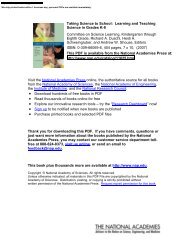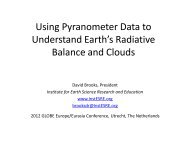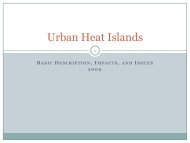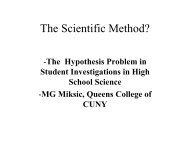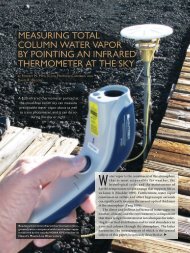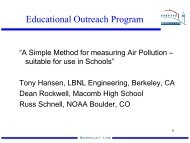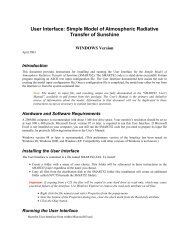Estimating Cloud Type from Pyranometer Observations - American ...
Estimating Cloud Type from Pyranometer Observations - American ...
Estimating Cloud Type from Pyranometer Observations - American ...
You also want an ePaper? Increase the reach of your titles
YUMPU automatically turns print PDFs into web optimized ePapers that Google loves.
JANUARY 1999 DUCHON AND O’MALLEY<br />
141<br />
cloudiness relative to a human observer. We noted also<br />
that aerosols can fool the pyranometer method into classifying<br />
an otherwise clear sky into cirrus because the<br />
time series of their irradiances can be quite similar, as<br />
shown in Figs. 8 and 9. As best as we can determine,<br />
many of the mismatches in our comparison study occur<br />
because of aerosols. The estimation of aerosols using<br />
only a pyranometer is not possible. More elaborate instrumentation<br />
is required. In the case of haze in the<br />
planetary boundary layer (PBL), ASOS visibility measurements<br />
may be useful to document its occurrence so<br />
that a corrective measure can be taken. In the case of<br />
aerosols within or above the PBL, Harrison and Michalsky<br />
(1994) describe a ground-based method to estimate<br />
optical depth. Unfortunately, the added cost of the<br />
associated instrumentation is prohibitive to widespread<br />
installation.<br />
Stratocumulus presents a special problem because its<br />
appearance varies <strong>from</strong> nearly cumuloform to nearly<br />
stratiform. For comparison purposes a simple algorithm<br />
was designed to classify stratocumulus as either cumulus<br />
or stratus, depending on fractional cloud cover<br />
estimated by the observer. While this approach usually<br />
is successful, cloud-type mismatches between the two<br />
methods do occur. Last, because sharp boundaries separate<br />
cloud-type categories, as seen in Fig. 5, small differences<br />
in the two statistical properties can lead to a<br />
mismatch between the observer classification and that<br />
by the pyranometer method.<br />
Apart <strong>from</strong> the aerosol problem, we are not aware of<br />
any intrinsic reason the cloud-type classification developed<br />
here and shown in Fig. 5 cannot be applied at<br />
other locations. In general, we expect the pyranometer<br />
method to provide a more accurate report of cloud type<br />
at lower rather than higher latitudes. This is because the<br />
solar beam is passing through more of the vertical depth<br />
of the cloud(s) than slant thickness. It is evident that in<br />
locations where aerosols are a common feature, such as<br />
in the southern plains, identification of a simple and<br />
effective means to account for them would significantly<br />
improve the cloud-type classification using the pyranometer<br />
method.<br />
In conclusion, an analysis of the time series of irradiance<br />
<strong>from</strong> a pyranometer can provide a useful assessment<br />
of cloud type where none is otherwise available<br />
but is desired. The method has merit with respect<br />
to the applications identified in section 1, but will always<br />
be limited to estimating cloud type in only a portion of<br />
the sky. Solving the aerosol problem will require additional<br />
instrumentation.<br />
Acknowledgments. This research was supported by<br />
the Environmental Sciences Division of the U.S. Department<br />
of Energy (through Battelle PNNL Contract<br />
144880-A-Q1 to the Cooperative Institute for Mesoscale<br />
Meteorological Studies) as part of the Atmospheric Radiation<br />
Measurement Program.<br />
REFERENCES<br />
Atwater, M. A., and P. S. Brown, 1974: Numerical computations of<br />
the latitudinal variation of solar radiation for an atmosphere of<br />
varying opacity. J. Appl. Meteor., 13, 289–297.<br />
, and J. T. Ball, 1981: A surface solar radiation model for cloudy<br />
atmospheres. Mon. Wea. Rev., 109, 878–888.<br />
Barnett, T. P., J. Ritchie, J. Foat, and G. Stokes, 1998: On the space–<br />
time scales of the surface solar radiation field. J. Climate, 11,<br />
88–96.<br />
Bland, W. L., 1996: Uncertainty of daily insolation estimates <strong>from</strong> a<br />
mesoscale pyranometer network. J. Atmos. Oceanic Technol.,<br />
13, 255–261.<br />
Brock, F. V., K. C. Crawford, R. L. Elliott, G. W. Cuperus, S. J.<br />
Stadler, H. L. Johnson, and M. D. Eilts, 1995: The Oklahoma<br />
Mesonet: A technical review. J. Atmos. Oceanic Technol., 12,<br />
5–19.<br />
Coakley, J. A., R. D. Cess, and F. B. Yurevich, 1983: The effect of<br />
tropospheric aerosols on the earth’s radiation budget: A parameterization<br />
for climate models. J. Atmos. Sci., 40, 116–138.<br />
Eppley Laboratory, Inc., 1976: Instrumentation for the measurement<br />
of the components of solar and terrestrial radiation. Eppley Laboratory,<br />
Inc., Newport, RI, 12 pp.<br />
Harrison, L., and J. Michalsky, 1994: Objective algorithms for the<br />
retrieval of optical depths <strong>from</strong> ground-based measurements.<br />
Appl. Opt., 33, 5126–5132.<br />
Iqbal, M., 1983: An Introduction to Solar Radiation. Academic Press,<br />
390 pp.<br />
Kondratyev, K. Ya., 1969: Radiation in the Atmosphere. Academic<br />
Press, 912 pp.<br />
List, R. J., 1968: Smithsonian Meteorological Tables. 6th ed. Smithsonian<br />
Institution Press, 527 pp.<br />
McDonald, J. E., 1960: Direct absorption of solar radiation by atmospheric<br />
water vapor. J. Meteor., 17, 319–328.<br />
Meyers, T. P., and R. F. Dale, 1983: Predicting daily insolation with<br />
hourly cloud height and coverage. J. Climate Appl. Meteor., 22,<br />
537–545.<br />
Michalsky, J. J., 1988: The Astronomical Almanac’s algorithm for<br />
approximate solar position (1950–2050). Sol. Energy, 40, 227–<br />
235.<br />
O’Malley, M. S., 1996: Determining daytime radiation and cloud<br />
climatologies <strong>from</strong> time series of surface irradiances <strong>from</strong> the<br />
ARM/CART Central Facility. M.S. thesis, School of Meteorology,<br />
University of Oklahoma, 109 pp. [Available <strong>from</strong> School<br />
of Meteorology, University of Oklahoma, Norman, OK 73019.]<br />
Rossow, W. B., and R. A. Schiffer, 1991: ISCCP cloud data products.<br />
Bull. Amer. Meteor. Soc., 72, 2–20.<br />
Smith, W. L., 1966: Note on the relationship between total precipitable<br />
water and surface dewpoint. J. Appl. Meteor., 5, 726–727.<br />
Stokes, G. M., and S. E. Schwartz, 1994: The Atmospheric Radiation<br />
Measurement (ARM) program: Programmatic background and<br />
design of the cloud and Radiation test bed. Bull. Amer. Meteor.<br />
Soc., 75, 1201–1221.




